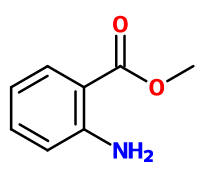
Photo credits: ScenTree SAS
| Company | Ingredient Name | ID | Comments | Naturality | Certifications | Purity | Latin name | Treated part | Geographical origin | MOQ |
|---|---|---|---|---|---|---|---|---|---|---|
|
|
Anthranilate de Methyle - 30 Gr | - |
Visit website
|
- | - | - | - | - | - |
General Presentation
-
CAS N° : 134-20-3
-
EINECS number : 205-132-4
-
FEMA number : 2682
-
FLAVIS number : 09.715
-
JECFA number : 1534
-
Appearance : Colorless liquid to solid
-
Density : 1,166
-
Volatility : Heart
-
Price Range : €
Physico-chemical properties
-
Molecular formula : C8H9NO2
-
Molecular Weight : 151,16 g/mol
-
Log P : 1,66
-
Fusion Point : 24°C
-
Boiling Point : 255°C
-
Detection Threshold : 0,12 ng/l air
-
Optical rotation : Donnée indisponible
-
Vapor pressure : Donnée indisponible
-
Refractive Index @20°C : Donnée indisponible
-
Acid Value : Donnée indisponible.
-
Flash Point : 123°C
Uses
Uses in perfumery :
Methyl Anthranilate is used for wild strawberry and wild fruit notes, in orange blossom and exotic flower accords: gardenia, tuberose, jasmine.
Year of discovery :
1898
Natural availability :
Methyl Anthranilate is present in Grandiflorum Jasmine Absolute, Neroli EO, Ylang-Ylang Extra EO (and other ylang fractions), Champaca Absolute, in grapes and citrus fruits, from which it can be extracted in its natural state.
Isomerism :
Methyl Anthranilate does not have any isomer used in perfumery.
Synthesis precursor :
Methyl Anthranilate has the ability to easily react with aldehydes to form molecules called Schiff bases, which can serve as a perfumery ingredient or base for a Maillard reaction. For example, Aurantiol (Schiff Base) results from the reaction of this molecule with Hydroxycitronellal and is a raw material also used in perfumery. The Schiff base with Lilial® (Verdantiol) or the one with Triplal® (Vertosine) are also much used.
Synthesis route :
Methyl Anthranilate is synthesized either by esterification of anthranilic acid with methanol or by reaction between methanol and isatoic anhydride, releasing CO2.
Regulations & IFRA
Allergens :
This ingredient does not contain any allergen.
IFRA 51th :
This ingredient is not restricted for the 51th amendment


